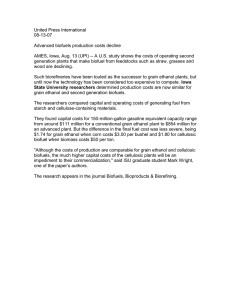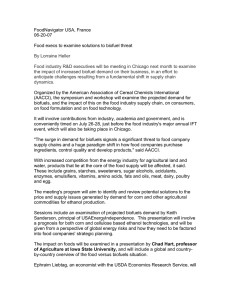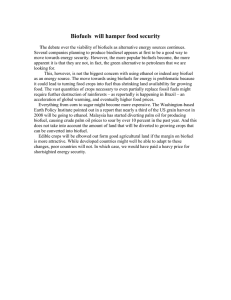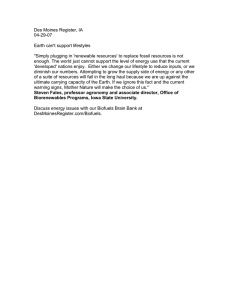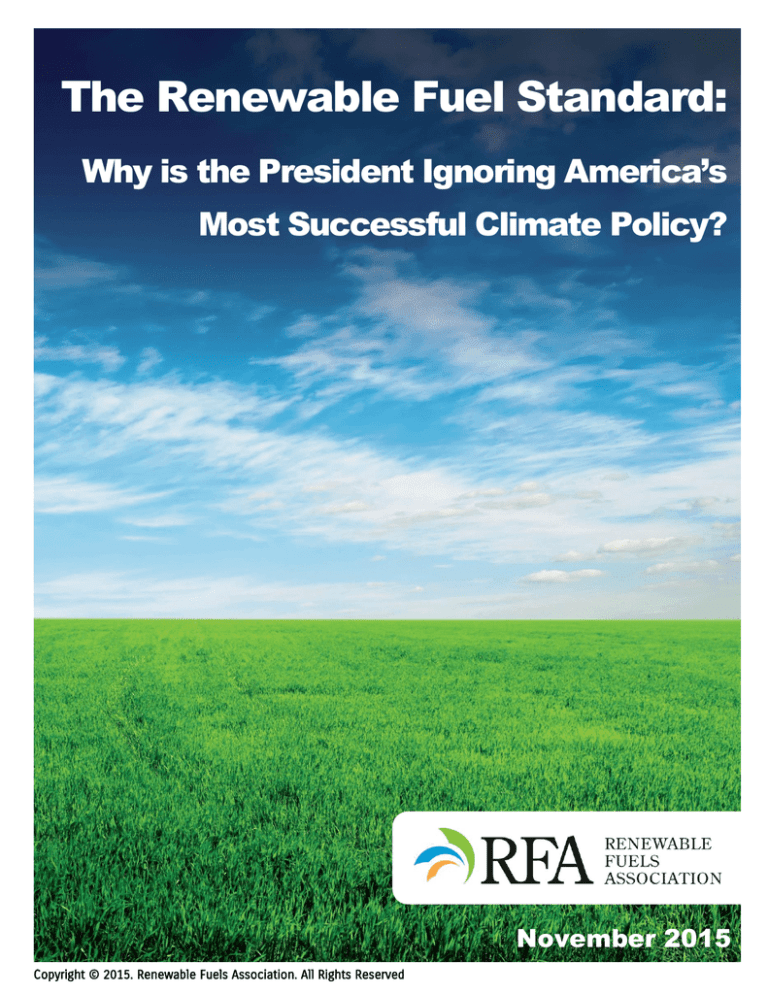
The Renewable Fuel Standard:
Why is the President Ignoring America’s
Most Successful Climate Policy?
November 2015
Copyright © 2015. Renewable Fuels Association. All Rights Reserved
Introduction
Since its inception in 2005, the U.S. Renewable Fuel Standard (RFS) has been remarkably
successful in driving expansion of domestic biofuels production and use, reducing petroleum
consumption, and cutting greenhouse gas (GHG) emissions from the transportation sector.
Transportation-related emissions—which account for 27% of total U.S. GHG emissions—have
steadily trended downward since adoption of the RFS, and current levels are 10% below 2005
levels.1 The U.S. Environmental Protection Agency (EPA) cites “using renewable fuels such as lowcarbon biofuels” as an important factor in reduced GHG emissions from the transportation sector,
while the U.S. Department of Energy (DOE) states that “increased consumption of biofuels” is a
key reason that transportation-related GHG emissions are falling faster than vehicle miles
traveled.2,3
As a result of these successes, the U.S. RFS has been widely heralded around the world as the
preeminent example of how progressive energy and climate policy can stimulate technology
innovation and help de-carbonize transportation systems. For the past decade, the United States
has been viewed as a global pacesetter in renewable fuel and climate policy, and nations around
the world have endeavored to emulate the RFS model.
Indeed, as world leaders gather in Paris in December for the 21st Session of the Conference of
the Parties to the U.N. Framework Convention of Climate Change (COP21), many nations will lay
out plans to implement RFS-like policies and
What is an INDC?
expand biofuels usage as a means of reducing GHG
An
“Intended
Nationally
Determined
emissions. Our review of “Intended Nationally
Contribution,” or INDC, outlines the actions a
Determined Contribution” (INDC) submissions
country intends to take as part of the Paris
reveals that increased use of biofuels is expected
international climate agreement. INDCs often
describe specific policy measures and actions
to play a central role in achieving the GHG
that a country will implement to reduce GHG
reduction commitments of nearly 30 countries,
emissions and combat climate change.
including both developed and developing nations.
Surprisingly, however, as nations around the world are following the U.S. lead on biofuels policy,
the INDC submission from the United States itself does not identify the RFS as a component of
planned post-2020 U.S. climate actions, nor does it mention biofuels as a key catalyst of the GHG
reductions observed over the past decade. In fact, the terms “RFS” and “biofuels” don’t even
appear in the U.S. submission. Thus, while other countries—from Brazil to India to Uruguay—will
proudly promote the achievements of their biofuels industries and pledge to redouble efforts to
expand biofuels at COP21, the United States appears poised to ignore the most successful U.S.
climate-energy policy ever enacted.
U.S. EPA (2014). U.S. Greenhouse Gas Inventory. http://www3.epa.gov/climatechange/ghgemissions/usinventoryreport.html
U.S. EPA. Sources of GHG Emissions. http://www3.epa.gov/climatechange/ghgemissions/sources/transportation.html#Trends
3
U.S. Energy Information Administration (2011). Emissions of GHGs in the United States, 2009
http://www.eia.gov/environment/emissions/ghg_report/pdf/0573%282009%29.pdf
1
2
1
Background
The Energy Policy Act (EPAct) was signed into law in August 2005, establishing the first-ever
Renewable Fuel Standard (RFS). The original RFS required gasoline refiners, blenders and
importers to incorporate annually increasing volumes of renewable fuels into the gasoline supply,
starting with 4 billion gallons (bg) in 2006 and rising to 7.5 bg by 2012.
Just two years later, against a backdrop of rising petroleum imports and spiking oil prices,
Congress passed the Energy Independence and Security Act (EISA). Among other provisions, EISA
greatly extended the RFS and expanded its scope. The expanded RFS (often called “RFS2”)
required gasoline and diesel refiners and importers to blend at least 9 bg of renewable fuel into
the fuel supply in 2008, increasing to 36 bg by 2022—roughly 25% of projected gasoline demand.
In addition, the RFS2 distinguished between conventional biofuels, advanced and cellulosic
biofuels, and biomass-based diesel, creating specific annual volumetric requirements for each.
The RFS2 program also established sustainability requirements for renewable fuels, including land
use restrictions and GHG reduction criteria. Specifically, in order to qualify for the RFS2,
conventional biofuels must reduce GHG emissions by at least 20% compared to petroleum,
advanced biofuels must reduce GHGs by 50%, and cellulosic biofuels must achieve a 60% or
greater GHG reduction. Finally, EISA capped the amount of corn ethanol that could contribute to
the RFS2 at 15 bg in 2015, requiring that all post-2015 growth come from advanced biofuels.
Passage of the RFS in 2005 finally guaranteed
that biofuels would have access to a market
traditionally dominated by petroleum. In
response to the market certainty provided by
the RFS, investment in renewable fuel
technologies and production facilities surged.
In 2006, ethanol production rose to 4.9 bg,
23% higher than the RFS requirement for that
year and more than double the output from
just four years earlier. By 2008, ethanol output
had virtually doubled again to 9.3 bg. By 2010,
ethanol accounted for almost 10% of the
nation’s gasoline supply; and in 2014, U.S.
ethanol output set a new record of 14.3 bg.
Meanwhile, just as envisioned by Congress in
2007, advanced biofuels production and use
began its own surge, with consumption
ramping up from about 1 bg (ethanol
equivalent) in 2006 to roughly 3 bg in 2014.
U.S. Renewable Fuel Standard
Cellulosic Biofuel (-60% GHG)
Advanced Biofuel (-50% GHG)
Biomass-based Diesel (-50% GHG)
Renewable Fuel (-20% GHG)
RFS1
36
32
24
20
16
12
8
4
0
2006
2007
2008
2009
2010
2011
2012
2013
2014
2015
2016
2017
2018
2019
2020
2021
2022
Billion Gallons
28
2
RFS a “Vital Part” of U.S. Climate Strategy
Million Metric Tons
The expansion of biofuels consumption under the RFS has inarguably reduced GHG emissions
from the transportation sector. In 2007, the U.S. Department of Energy’s Argonne National
Laboratory estimated that “average” corn ethanol reduced full lifecycle GHG emissions by 19%
compared to gasoline, while ethanol produced at newer plants using the “dry mill” process
reduced GHG emissions by 28%.4 The latest analysis from Argonne finds that 2012-era corn
ethanol reduced GHG emissions by 34%, on average, compared to gasoline. Notably, this estimate
includes consideration of theoretical emissions associated with potential indirect land use
changes stimulated by biofuels expansion.5 U.S. EPA’s own analysis, which assumes a far larger
theoretical land use change emissions impact, has recently certified that corn ethanol produced
using today’s technology reduces GHG emissions by 20-29% compared to 2005-era gasoline.6
Avoided CO2e Emissions Resulting from Grain
Ethanol Substitution for Gasoline in United
States, 2007-2015
38.1
40
35.1 36.5
33.3
35
28.0
30
22.5
25
17.1
20
15
10
12.6
8.5
5
0
Substituting ethanol for gasoline in the
U.S. has resulted in substantial
aggregate GHG emission reductions
from the transportation sector, ramping
up from 8.5 million metric tons (mmt) of
avoided CO2-equivalent in 2007 to a
projected 38.1 mmt in 2015.7 The
cumulative GHG savings resulting from
U.S. grain ethanol consumption since
2007 is roughly 232 mmt of CO2e,
which is the equivalent of removing
more than 5 million cars from the road
each year since RFS2 enactment.
Notably, the GHG savings discussed here only account for the contributions of grain ethanol
(corn/milo) under the RFS; increased use of advanced biofuels in recent years provides additional
GHG reductions not accounted for in this report. Analyses by Argonne show that biodiesel and
renewable diesel reduce emissions by more than 50% compared to petroleum, while emergent
cellulosic biofuels provide GHG savings in the range of 88-108%.8 Indeed, the proven GHG
reductions resulting from biofuels use under the RFS prompted U.S. EPA Administrator Gina
McCarthy to recently remark that “the RFS is a tool to address climate change. That is what it is
designed for…” and that biofuels are a “vital part of the president’s climate-change agenda.”9
4
M. Wang, M. Wu & H. Huo. “Life-cycle energy and greenhouse gas emissions impacts of different corn ethanol plant types.”
Environ. Res. Lett. 2 (2007) 024001 (13 pp).
M. Wang et al. “Well-to-wheels energy use and greenhouse gas emissions of ethanol from corn, sugarcane and cellulosic
biomass for US use.” Environ. Res. Lett., 7 (2012) 045905 (13pp).
6
U.S. EPA. Approved Pathways for Renewable Fuel. http://www2.epa.gov/renewable-fuel-standard-program/approvedpathways-renewable-fuel
7
See Appendix for details on calculations of GHG savings.
8
M. Wang et al. (2012). See footnote 5.
9
The Hagstrom Report (Sep. 15, 2015). “McCarthy: EPA will stick to schedule on the RFS.”
http://www.hagstromreport.com/2015news_files/2015_0915_mccarthy-epa-stick-schedule-rfs.html
5
3
Biofuels Play Central Role in Nearly 30 Countries’ Climate Action Plans
Dozens of other nations apparently agree with Administrator McCarthy that biofuels are an
important tool for fighting climate change. In fact, nearly one quarter of the INDCs submitted to
the U.N. prominently feature biofuels policy measures as part of their post-2020 climate action
plans. For example, in the weeks leading up to Paris, Brazilian President Dilma Rousseff proudly
proclaimed that “no car moves without ethanol in this country,”10 and the country’s INDC states
that “Brazil already has one of the largest and most successful biofuel programs to date.” The
INDC also includes “expanding biofuel consumption” and “increasing ethanol supply” as
measures the nation intends to adopt to further reduce GHG emissions.
Brazil isn’t alone in recognizing the ability of biofuels to combat climate change. As shown in the
table below, nearly 30 of the 128 submitted INDCs include some discussion of biofuels as a
strategy for meeting GHG emissions reduction commitments made under COP21.11
COUNTRY
ROLE OF BIOFUELS IN INDC
Argentina
Cites “actions linked to biofuels” as being a critical strategy for reducing GHG
emissions by 15% by 2030.
Barbados
States that the country is “investing in alternative vehicles and fuels such
as…ethanol…and encouraging their adoption through tax incentives.”
Belize
Lists “promoting the use of bio-fuels” as a means of meeting goal to reduce
transportation-related GHG by 20% by 2033.
Brazil
Announces intent to “increase the share of sustainable biofuels in the Brazilian
energy mix to approximately 18% by 2030, by expanding biofuel consumption,
increasing ethanol supply, and increasing the share of advanced biofuels…”
Proclaims that “Brazil already has one of the largest and most successful biofuel
programs to date.”
Burkina Faso
Includes target of 10% ethanol blends and 5% biodiesel blends by 2030 as a GHG
mitigation strategy.
Cabo Verde
Includes use of biodiesel as a means of increasing renewable energy
consumption by 2020-2025.
Canada
States that Canada “has in place legislative instruments to address climate
change…” and highlights that “renewable fuels regulations require that gasoline
contain an average 5% renewable fuel content and that most diesel fuel contain
an average 2% content.”
Agencia Brasil (Oct. 14, 2015). “Rousseff asks for unity and says crisis is moment for building bridges.”
http://agenciabrasil.ebc.com.br/en/politica/noticia/2015-10/rousseff-asks-unity-and-says-crisis-moment-building-bridges
11
As of Oct. 30, 2015, 128 INDC submissions had been posted on the UNFCCC INDC website.
http://unfccc.int/focus/indc_portal/items/8766.php
10
4
Congo
Lists “agro industry/biofuels” as an action being taken by the government to
meet GHG reduction targets.
Ethiopia
Highlights that “ethanol has already…enable[d] enhanced generation and use of
clean and renewable energy."
Grenada
Cites “introduction of biofuels” as a strategy for reducing transportation sector
emissions by 20% by 2025.
Guinea
Plans to “increase the supply of biofuels” as part of a goal to achieve 30%
renewable energy by 2030.
Guyana
States that “Guyana is interested in piloting small scale fermentation and
distillation techniques for the production of ethanol and [other] bio-fuels.”
India
Cites “National Policy on Biofuels,” which includes targets of “20% blending of
biofuels, both for bio-diesel and bio-ethanol.”
Kiribati
Includes “use of coconut oil as biodiesel for transport” as a GHG mitigation
objective.
Laos
Lists “Renewable Energy Strategy” as a key component of GHG mitigation plan,
including an objective to “increase the share of biofuels to meet 10% of the
demand for transport fuel by 2025.”
Liberia
Mitigation scenario includes use of 5% biofuels in transportation fuels mix.
Macedonia
Plans to get 5% of energy supply from biofuels by 2020, or as much as 10%
under a “higher ambition mitigation scenario.”
Malawi
Endeavors to “produce 18 million litres of ethanol per year” and conditionally
increase production to 40 million litres of ethanol per year.
Mali
Includes “local biofuel production” as a means of addressing GHG emissions.
Mozambique
Intends to implement “biofuels policy and strategy” to assist in mitigating GHG
emissions between 2020 and 2030.
Norway
States that government will maintain tax exemptions for bioethanol and
biodiesel through 2020.
Philippines
References “Biofuels Act of 2006” as a successful action that “led to the
increase in the utilization of renewable energy sources, reinforcing and
institutionalizing climate change mitigation actions.”
Seychelles
Intends to amend import regulations to increase use of biofuels and fuel efficient
vehicle technologies.
Sierra Leone
Cites development of alternative energy sources such as bio-fuels from
sugarcane, corn, and rice hulls as a potential GHG mitigation strategy.
Swaziland
Plans to “introduce the commercial use of a 10% ethanol blend in petrol by 2030.”
5
Uruguay
Aims to “increase the percentage of biofuels in gasoline and diesel” and states
that currently “the use of biodiesel accounts for 7% and bioethanol 10% of total
vehicle fleet, both with entirely domestic production.”
Zambia
Intends to “introduce and increase blending of bio-fuels with fossil fuels and,
where possible, [complete] substitution with bio-fuels.”
Zimbabwe
References implementation of the country’s “biofuels policy” and “ethanol
blending” as GHG mitigation strategies.
RFS Not “Vital” Enough to Appear in U.S. INDC?
While measures to increase biofuels consumption appear in the INDC submissions of countries
from all over the world, the RFS and biofuels are conspicuously absent from the U.S. INDC. Is this
purposeful omission indicative of a larger shift in biofuels policy support in the U.S.? Perhaps.
In May 2015, the administration released a proposal that would, for the first time ever, reduce the
RFS program’s total renewable fuel and advanced biofuel blending requirements to levels below
the volumes established by Congress in 2007.12 Inexplicably, the proposal adopts the petroleum
industry’s self-interested position that the U.S. fuel supply simply can’t absorb any more biofuel,
even though the biofuels industry has ample capacity to supply the volumes specified in the law.
This sets up quite a dilemma for the White House as world leaders embark for Paris. How can
President Barack Obama suggest the United States is leading the world in combating climate
change when his administration’s own proposals seek to eviscerate the most successful
transportation-related GHG mitigation strategy ever adopted? The president’s predicament is
further complicated by the fact that the Paris climate talks are scheduled to begin on November
30—the exact same date that U.S. EPA is expected to release the final rule for 2014-2016 RFS
volume requirements.
The U.S. INDC submission states that “[t]he United States has already undertaken substantial
policy action to reduce its emissions…” yet fails to reference the RFS as one of those actions.
The document outlines a GHG reduction target of 26-28% below 2005 levels by 2025, and
suggests that “[a] number of existing laws, regulations, and other domestically mandatory
measures are relevant to the implementation of the target…” The INDC goes on to cite the
following specific actions as “relevant” to meeting the goal:
fuel economy standards;
commercial building measures;
energy conservation standards for appliances and equipment;
power plant emissions standards;
U.S. EPA. Proposed RFS for 2014, 2015 and 2016, and Biomass-Based Diesel Volume for 2017.
http://www2.epa.gov/renewable-fuel-standard-program/proposed-renewable-fuel-standards-2014-2015-and-2016-andbiomass
12
6
reduced use of hydrofluorocarbons with high global warming potential;
methane emissions controls for landfills and oil/gas operations; and
reduced GHG emissions from Federal government operations.
Not a single mention of the RFS is included in the U.S. INDC submission, despite the fact that the
program has delivered real GHG savings and served as the “gold standard” example of energyclimate policy over the past decade.
Biofuel Producers Sign President Obama’s Climate Pledge
The snub to biofuels and the RFS in the U.S. INDC is even more perplexing given the fact that the
biofuel industry has strongly supported the president’s climate agenda. In fact, eight of the 81
companies signing on to President Obama’s American Business Act on Climate Pledge own and
operate U.S. biofuel production facilities, and several other companies signing the pledge are
technology providers to the biofuel supply chain.13 Companies who sign the pledge are “voicing
support for a strong Paris outcome” and “demonstrating an ongoing commitment to climate
action.” The following companies directly involved in biofuel production signed the pledge and
outlined specific actions they will take to reduce the carbon intensity of their products and
operations:
Abengoa Bioenergy US – owns and operates seven ethanol biorefineries in the U.S., as
well as ethanol and biodiesel facilities in Europe and South America
Aemetis, Inc. – owns and operates an ethanol biorefinery in the U.S., as well as an
advanced biofuel/renewable chemical facility in India
Cargill – owns and operates multiple ethanol and biodiesel facilities in the U.S. and
internationally
DSM North America – in partnership with POET, operates one of the world’s first
commercial-scale cellulosic ethanol biorefineries in the U.S.
Fulcrum Bioenergy, Inc. – developing a waste-to-fuel biorefinery project in the U.S.
Pacific Ethanol, Inc. – owns and operates eight ethanol biorefineries in the Western and
Midwestern U.S.
POET – owns and operates 27 ethanol biorefineries in the U.S., including one of the
world’s first commercial-scale cellulosic ethanol facilities (in partnership with DSM)
QCCP/Syngenta – QCCP owns and operates a cellulosic/conventional ethanol biorefinery in
the U.S.; in partnership with Syngenta, QCCP licenses cellulosic ethanol technology
Other companies signing the pledge, such as Monsanto and Novozymes, are also heavily engaged
in the U.S. and global biofuels industries. These businesses joined some of the world’s most
recognizable companies—including Apple, AT&T, Coca-Cola, GE, General Motors, Google, IBM,
The White House (Oct. 19, 2015). “FACT SHEET: White House Announces Commitments to the American Business Act on
Climate Pledge.” https://www.whitehouse.gov/the-press-office/2015/10/19/fact-sheet-white-house-announces-commitmentsamerican-business-act
13
7
McDonald’s, Microsoft, Proctor & Gamble, Starbucks, Target, Walmart—in supporting President
Obama’s objectives in Paris.
All of this begs an important question: Why isn’t the president using COP21 as an opportunity to
showcase the policy that has supported companies who share his vision for innovation and
combating climate change? Ironically, the administration’s proposal to roll back the RFS hurts the
very businesses who have pledged to support aggressive efforts to curb climate change.
Conclusion: U.S. Should Highlight—Not Hide—RFS Success Story in Paris
Given the accomplishments of the RFS program, one might expect that the United States would
be among the countries aggressively pursuing fortification and expansion of biofuels policies as a
means of further reducing GHG emissions under COP21 agreements. However, the U.S. INDC
submission does not mention the RFS or biofuels as a component of planned post-2020 U.S.
climate actions, nor does it identify the RFS as a key driver of the GHG reductions observed over
the past decade. In fact, the terms “RFS” and “biofuels” don’t even appear in the U.S. submission.
Thus, while nearly 30 other countries are expected to promote the achievements of their biofuels
industries and pledge to renew and expand renewable fuel policy commitments, the United
States appears poised to shun the most successful national energy-climate policy ever enacted.
While the exact reasons for omitting biofuels policy from the U.S. INDC remain unclear, all eyes
will be focused on President Obama’s approach to the RFS in the Paris climate discussions.
Biofuel producers, farmers and ranchers, climate advocates, clean-tech investors, national
security hawks, and others will all be watching Paris closely in hopes that President Obama
appropriately promotes the RFS program’s successful record of reducing U.S. GHG emissions, and
recognizes the ability of biofuels to play an even larger role in future efforts to combat climate
change.
8
Appendix:
Calculations of GHG Savings Resulting from Grain Ethanol Substitution for Gasoline, 2007-2015
Ethanol and Gasoline Energy Content1
Megajoule/Gal.
Ethanol
81.51
Gasoline
119.53
2007
2008
2009
2010
2011
2012
2013
2014
2015p
U.S. Ethanol
Gasoline
2
Blended
Equivalent
Million Gals.
5,737
3,913
7,984
5,445
10,120
6,902
12,007
8,189
12,485
8,515
12,775
8,713
13,044
8,896
13,321
9,085
13,658
9,315
Ethanol
Emissions
2007
2008
2009
2010
2011
2012
2013
2014
2015p
35.0
47.9
59.7
69.5
67.7
64.6
65.1
65.6
66.6
Ethanol Lifecycle
Gasoline Lifecycle
3
Carbon Intensity
Carbon Intensity4
g CO2e/MJ
74.9
93.0
73.6
93.0
72.3
93.0
71.0
94.0
66.5
94.0
62.0
94.0
61.2
94.0
60.4
94.0
59.8
94.0
Gasoline
Avoided Emissions
Equivalent
from Ethanol
Emissions
Substitution
Million MT CO2e
43.5
8.5
60.5
12.6
76.7
17.1
92.0
22.5
95.7
28.0
97.9
33.3
100.2
35.1
102.1
36.5
104.7
38.1
Argonne National Laboratory GREET1 2015 Model.
U.S. Energy Information Administration. “U.S. Refinery and Blender Net Input of Fuel Ethanol.” 2015 is projected based
on Jan.-Aug. totals. http://www.eia.gov/dnav/pet/hist/LeafHandler.ashx?n=PET&s=MFERIUS1&f=M
3
2007 based on M. Wang, M. Wu & H. Huo. “Life-cycle energy and greenhouse gas emission impacts of different corn
ethanol plant types.” Environ. Res. Lett. 2 (2007) 024001 (13 pp).; 2010 based on M. Wang et al. “Energy and
greenhouse gas emission effects of corn and cellulosic ethanol with technology improvements and land use changes.”
Biomass & Bioenergy 35 (2011) 1885-1896; 2012 based on M. Wang et al. “Well-to-wheels energy use and greenhouse
gas emissions of ethanol from corn, sugarcane and cellulosic biomass for US use.” Environ. Res. Lett., 7 (2012) 045905
(13pp); 2015 is based on GREET1_2015 model. 2008, 2009, 2011, 2013, 2014 are interpolated. Estimates from 20102015 include land use change emissions.
1
2
4
Id.


